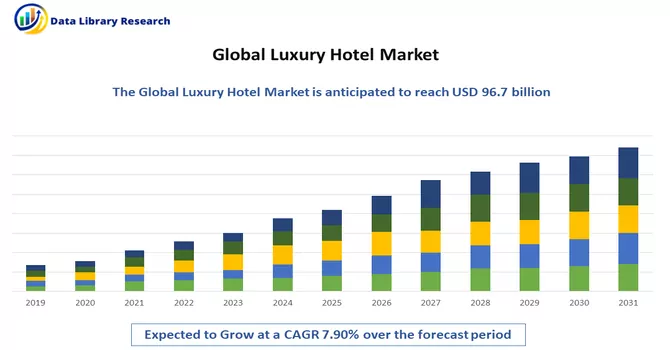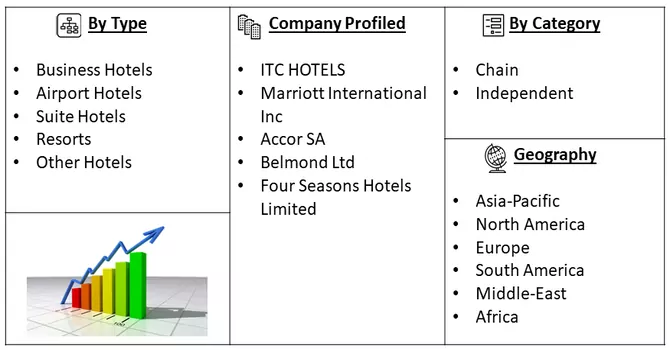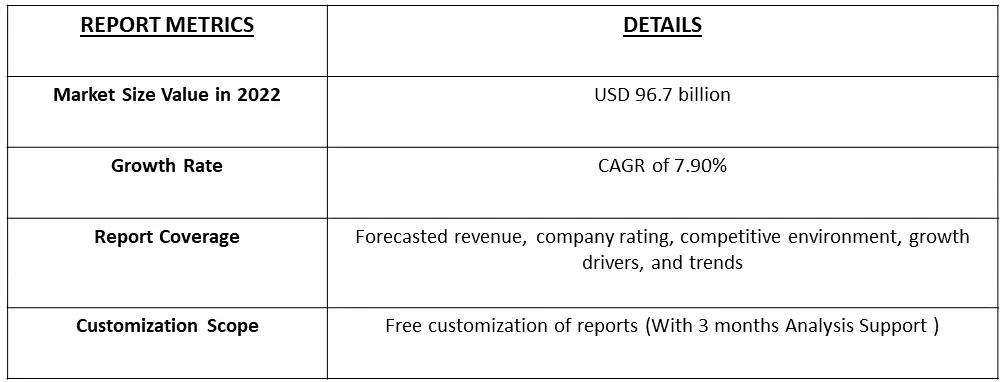The Luxury Hotel Market size is estimated at USD 96.7 billion in 2022, and is expected to register a CAGR of 7.90% during the forecast period (2023-2030).

Get Complete Analysis Of The Report - Download Free Sample PDF
A luxury hotel is a high-end and upscale accommodation establishment that offers an exceptional level of service, comfort, and amenities to its guests. Luxury hotels often boast exquisite interior decor and architecture that exude sophistication and style. Guests can expect spacious, well-furnished rooms or suites with high-quality linens, furniture, and state-of-the-art technology.
The growth of the travel and tourism industry, along with evolving standards of living, has sparked significant expansion in the trends of the luxury hotel market. The demand for luxury hotels is not uniform and is shaped by factors like their location, size, and available amenities. Factors contributing to this growth include increased disposable income, the rise in weekend getaways, the proliferation of affordable airline services, and the flourishing service sector. These factors are anticipated to be key drivers of the luxury hotel market.
Market Segmentation: The Global Luxury Hotel Market Share and is Segmented By Type (Business Hotels, Airport Hotels, Suite Hotels, Resorts, and Other Hotels) and By Geography (North America, Europe, Asia-Pacific, South America, and Middle-East and Africa).

For Detailed Market Segmentation - Download Free Sample PDF
Market Drivers:
Increase in Disposable Income
With higher disposable income, travelers are more inclined to book longer stays and opt for room upgrades, such as suites or specialty rooms. Luxury hotels often offer a range of options for guests seeking enhanced comfort and luxury. Guests with higher disposable income are more likely to explore and enjoy the fine dining and spa facilities that luxury hotels often provide. They are willing to spend on gourmet meals, wellness treatments, and recreational activities offered by these establishments. Business travelers with increased disposable income may opt for luxury hotels, which provide a conducive environment for meetings and networking. They can also take advantage of amenities like business centers and concierge services. Thus, the market is expected to witness significant growth of the forecast period.
Rise in Weekend Getaways, the Proliferation of Affordable Airline Services, and the Flourishing Service Sector
Weekend getaways have become a favored way for individuals and families to escape from their daily routines and rejuvenate. As people increasingly prioritize work-life balance, they seek short breaks to unwind and de-stress without the need for extended vacations. Weekend getaways often involve destinations that are relatively close to one's place of residence, making them convenient and accessible. This synergy between weekend getaways, affordable airline services, and the flourishing service sector in the luxury market has led to a transformation in the way people plan and enjoy their short breaks. It has not only expanded the scope of travel but also created opportunities for the luxury hospitality sector to thrive by meeting the evolving demands and preferences of weekend travelers.
Market Restraints:
Economic Downturns and Fluctuations
Economic downturns are typically characterized by decreased consumer confidence and spending. As people become more budget-conscious during uncertain times, they tend to cut back on discretionary expenses, including luxury products and services. In the studied market, this can lead to a decrease in demand for high-end goods and experiences, including luxury accommodations. Economic fluctuations often lead to cost-cutting measures within companies, including reduced travel budgets. As a result, businesses may curtail or scale back corporate travel, impacting the demand for luxury hotel accommodations that often cater to business travelers, thus slowing down the growth of the studied market.
The COVID-19 pandemic disrupted the luxury market in multifaceted ways, challenging the traditional dynamics and priorities of luxury consumers and businesses. While it posed significant challenges, it also accelerated certain trends and led to adaptations that may continue to shape the luxury market in the post-pandemic era. Luxury brands and businesses have had to be agile, innovative, and responsive to changing consumer needs and preferences in the wake of this unprecedented global crisis. Moreover, As international travel faced restrictions, luxury travelers explored domestic and regional destinations. This shift in travel preferences gave rise to "staycations" and a rediscovery of local luxury offerings. In the current scenario, with the coming back to normal situation, the market is expected to witness significant growth over the forecast period.
Segmental Analysis:
Resorts Segment is Expected to Witness Significant growth Over the Forecast Period
Resorts and luxury hotels represent the zenith of hospitality, offering guests an unparalleled experience of opulence, relaxation, and indulgence. These exquisite establishments are renowned for their exceptional service, lavish accommodations, and a wide array of amenities that cater to the desires and expectations of discerning travelers. Resorts and luxury hotels are celebrated for their sumptuous accommodations, which often include spacious rooms, suites, and private villas. High-quality linens, luxurious furnishings, and state-of-the-art technology are common features. Fine dining is a hallmark of resorts and luxury hotels, with multiple gourmet restaurants and bars offering an array of culinary delights. Guests can savor world-class cuisine and an extensive selection of beverages. Thus, owing to such advantages the segment is expected to witness significant growth over the forecast period.
North America Region is Expected to Witness Significant growth Over the Forecast Period
North America is home to a remarkable array of luxury hotels that cater to the most discerning travelers seeking lavish experiences and impeccable service. This vast continent offers a diverse range of landscapes, from cosmopolitan cities to pristine natural wonders, and luxury hotels in North America have positioned themselves as gateways to exploring these extraordinary destinations.
North America boasts a stunning array of destinations, from the iconic cities like New York and Los Angeles to the natural wonders of the Grand Canyon, Niagara Falls, and the Rocky Mountains. Luxury hotels in this region are strategically located to offer guests access to these incredible locales.
The region is a melting pot of culinary influences, and luxury hotels in North America reflect this diversity in their dining options. Guests can indulge in world-class cuisine, often featuring locally sourced ingredients, in on-site restaurants and bars. As a result, the region is expected to witness significant growth over the forecast period.

Get Complete Analysis Of The Report - Download Free Sample PDF
The report delves into the prominent global players in the luxury hotel market. Presently, a handful of these major players hold significant market share. Nevertheless, due to factors such as technological progress, novel service offerings, infrastructure enhancements facilitated by local authorities, and the availability of various amenities, the market is increasingly drawing the attention of both businesses and tourists. Some f the key market players working in this market segment are:
Recent Development:
1. In November 2020, Paris-based hotel company Accor and London-based hospitality firm Ennismore entered exclusive negotiations to form what they are claiming will be the world’s leading lifestyle operator in the hospitality sector. Through this all-share merger, a new autonomous asset-light entity will combine the Hoxton, Gleneagles, Delano, SLS, Mondrian, SO/, Hyde, Mama Shelter, 25h, 21c Museum Hotels, Tribe, Jo&Joe, and Working From brands.
2. In February 2020, London-based Hamilton Hotel Partners and Boston-based Pyramid Hotel Group completed the merger of the two businesses. The combined business or asset manages 141 hotels with 32,000 rooms across eight countries.
Q1. What was the Luxury Hotel Market size in 2022?
As per Data Library Research the Luxury Hotel Market size is estimated at USD 96.7 billion in 2022.
Q2. At what CAGR is the Luxury Hotel Market projected to grow within the forecast period?
Luxury Hotel Market is expected to register a CAGR of 7.90% during the forecast period.
Q3. Which Region is expected to hold the highest Market share?
North America region is expected to hold the highest Market share.
Q4. Who are the key players in Luxury Hotel Market?
Some key players operating in the market include:
Data Library Research are conducted by industry experts who offer insight on industry structure, market segmentations technology assessment and competitive landscape (CL), and penetration, as well as on emerging trends. Their analysis is based on primary interviews (~ 80%) and secondary research (~ 20%) as well as years of professional expertise in their respective industries. Adding to this, by analysing historical trends and current market positions, our analysts predict where the market will be headed for the next five years. Furthermore, the varying trends of segment & categories geographically presented are also studied and the estimated based on the primary & secondary research.
In this particular report from the supply side Data Library Research has conducted primary surveys (interviews) with the key level executives (VP, CEO’s, Marketing Director, Business Development Manager and SOFT) of the companies that active & prominent as well as the midsized organization
FIGURE 1: DLR RESEARH PROCESS

Extensive primary research was conducted to gain a deeper insight of the market and industry performance. The analysis is based on both primary and secondary research as well as years of professional expertise in the respective industries.
In addition to analysing current and historical trends, our analysts predict where the market is headed over the next five years.
It varies by segment for these categories geographically presented in the list of market tables. Speaking about this particular report we have conducted primary surveys (interviews) with the key level executives (VP, CEO’s, Marketing Director, Business Development Manager and many more) of the major players active in the market.
Secondary ResearchSecondary research was mainly used to collect and identify information useful for the extensive, technical, market-oriented, and Friend’s study of the Global Extra Neutral Alcohol. It was also used to obtain key information about major players, market classification and segmentation according to the industry trends, geographical markets, and developments related to the market and technology perspectives. For this study, analysts have gathered information from various credible sources, such as annual reports, sec filings, journals, white papers, SOFT presentations, and company web sites.
Market Size EstimationBoth, top-down and bottom-up approaches were used to estimate and validate the size of the Global market and to estimate the size of various other dependent submarkets in the overall Extra Neutral Alcohol. The key players in the market were identified through secondary research and their market contributions in the respective geographies were determined through primary and secondary research.
Forecast Model
